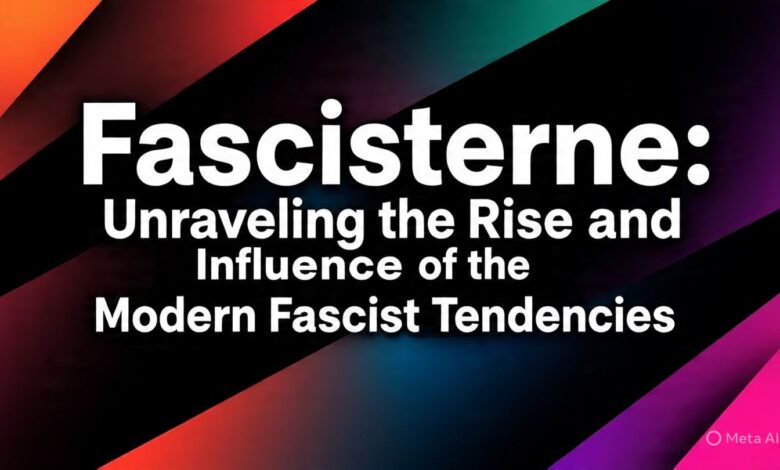Fascisterne: Unraveling the Rise and Influence of the Modern Fascist Tendencies

In recent years, the term fascisterne has quietly entered conversations across social media, political commentaries, and academic debates. Derived from a blend of “fascist” and “-erne” (a Scandinavian suffix implying plural or collective entities), fascisterne refers to a phenomenon that many are now observing with concern: the emergence and proliferation of fascist-like attitudes, groups, and ideologies in contemporary society.
This phenomenon is not confined to a single country or political spectrum. Instead, it manifests across borders, adapting to local contexts but often sharing core elements: authoritarian tendencies, xenophobia, disdain for pluralism, and sometimes, violent rhetoric. As a seasoned observer of political movements and a firm believer in the importance of understanding the undercurrents shaping our world, I’ve delved deep into what fascisterne really are, how they operate, and what they mean for the future of democracy.
In this comprehensive exploration, I’ll guide you through the origins of the term, dissect the characteristics of fascisterne, analyze their modern-day manifestations, and offer insights into how societies can recognize, counter, and ultimately understand this rising tide.
What Exactly Are Fascisterne?
The term fascisterne isn’t just a catchy neologism; it encapsulates a tangible shift in societal attitudes. While traditional fascism, rooted in the early 20th century, was characterized by totalitarian regimes like Nazi Germany and Fascist Italy, today’s fascisterne are not necessarily state-led but are instead grassroots or online movements that echo similar ideologies.
Fascisterne represent a spectrum rather than a fixed category. They include:
- Grassroots groups espousing authoritarian, anti-immigrant, or nationalist sentiments.
- Online communities spreading conspiracy theories, hate speech, and ultranationalist narratives.
- Political factions that adopt fascist rhetoric while operating within democratic frameworks.
- Individuals who, influenced by radical ideas, promote violence or suppression of dissent.
Despite differences in scale and tactics, their common thread ties back to a desire to impose a singular worldview through force, fear, or manipulation. Recognizing fascisterne requires understanding that they often cloak their beliefs in language that appears patriotic or protective, making them insidious and hard to pin down.
The Roots and Evolution of Fascisterne
Understanding fascisterne necessitates a look at their historical antecedents. Fascism, as a political ideology, emerged in the early 20th century during a period of upheaval—economic crises, social unrest, and disillusionment with liberal democracy. It thrived on fear, scapegoating, and the promise of order amidst chaos.
Fast forward to the 21st century, and many of these elements have resurfaced in new forms. The digital age has accelerated the spread of extremist ideas, providing fertile ground for fascisterne to grow. Social media algorithms tend to amplify sensationalist content, often aligning with the narratives promoted by fascisterne: anti-immigrant sentiments, anti-globalism, and anti-establishment rhetoric.
Recent studies from 2024 indicate that online hate groups have increased by over 30% globally since 2020, with many adopting the fascisterne label to organize, rally, and recruit. These groups tend to be highly adaptable, often shifting their language to evade bans but maintaining core beliefs.
Historically, fascisterne mirror earlier fascist groups in their tactics—propaganda, intimidation, and sometimes violence—but now leverage the internet’s reach to operate across borders more seamlessly than ever before.
Key Characteristics of Modern Fascisterne
To truly grasp what fascisterne are, one must analyze their defining traits. While individual groups or individuals may differ, several core characteristics tend to recur:
1. Authoritarian and Anti-Democratic Attitudes
Fascisterne often express disdain for democratic institutions, advocating instead for a centralized, authoritarian rule. They view liberal democracy as weak or corrupt, and some openly call for the overthrow of democratic systems.
2. Xenophobia and Ethnic Nationalism
A hallmark of fascisterne is their aggressive stance against minorities, immigrants, and international organizations. They promote an ethnocentric worldview, emphasizing racial or cultural superiority.
3. Propagation of Conspiracy Theories
Many fascisterne thrive on conspiracy narratives—claiming that societal issues are caused by elites, immigrants, or globalists working in tandem. These theories often serve to justify their exclusionary or violent actions.
4. Use of Propaganda and Symbolism
They employ symbols from historic fascist regimes (e.g., specific flags, salutes) or create new ones that evoke a sense of unity or rebellion. Propaganda is tailored to resonate emotionally, often utilizing social media memes, videos, or slogans.
5. Violence and Intimidation
While not all fascisterne engage in violence, a significant subset do, especially when their narratives are challenged. Hate crimes, assaults, and threats are common tactics to silence opponents.
6. Online Presence and Cyber Tactics
The internet is a central battleground for fascisterne. They use encrypted channels, social media platforms, and forums to organize, recruit, and spread their message. Their online tactics include trolling, misinformation campaigns, and coordinated harassment.
How Fascisterne Manifest in the Real World
The influence of fascisterne isn’t confined to online spaces; it has tangible effects across societies. Recent case studies from 2024 highlight how these groups influence politics, social cohesion, and security.
Case Study 1: The Rise of Neo-Nazi Groups in Scandinavia
In 2023, several groups identified as fascisterne gained ground in Scandinavian countries. They organized rallies, disseminated neo-Nazi symbols, and targeted minority communities with threats. Law enforcement agencies responded by tightening monitoring, but the groups continue to adapt their tactics.
Case Study 2: Online Radicalization in the United States
Multiple reports indicate a surge in online communities promoting fascisterne ideologies. These groups often frame themselves as defenders of traditional values but promote white supremacy and anti-immigrant policies. Several individuals involved in violent incidents in 2024 had clear ties to these online networks.
Case Study 3: Political Exploitation in Eastern Europe
Certain political factions have leveraged fascisterne-like rhetoric to mobilize support. By framing immigration or EU policies as threats, they energize nationalist bases, sometimes resulting in violent clashes or hate crimes.
Real-World Impact
The presence of fascisterne directly correlates with rising hate crimes, polarization, and threats to social cohesion. Governments are increasingly aware of the need to address these phenomena not just legally but through community engagement and education.
Recognizing and Counteracting Fascisterne
Awareness is the first line of defense. Recognizing fascisterne involves understanding their tactics and rhetoric without falling into overgeneralizations.
Practical Tips for Identification:
- Language cues: Use of xenophobic, racist, or ultranationalist language.
- Symbols and imagery: Adoption of historic fascist symbols or creation of new, provocative iconography.
- Online behavior: Engagement in coordinated trolling, spreading conspiracy theories, or harboring violent threats.
- Public actions: Rallies or demonstrations that promote authoritarian or exclusionary messages.
Strategies to Counteract:
- Community engagement: Building strong, inclusive communities reduces susceptibility to extremist narratives.
- Legal measures: Enforcing anti-hate speech laws and monitoring online hate groups.
- Education: Promoting critical media literacy and teaching the history of fascism to foster resilience.
- Platform moderation: Encouraging social media companies to proactively identify and remove fascisterne content.
The Role of Individuals
Everyone can play a part by questioning and challenging hateful rhetoric, supporting victims of hate crimes, and staying informed. Recognizing the signs early can prevent radicalization and the escalation of violence.
The Future of Fascisterne and Societal Resilience
The trajectory of fascisterne remains uncertain but increasingly concerning. As technology evolves, so do their tactics. However, societies worldwide are also learning to respond more effectively.
Recent developments include:
- Enhanced legal frameworks targeting online hate speech.
- International cooperation to dismantle transnational extremist networks.
- Educational initiatives designed to foster empathy and historical awareness.
Crucially, resilience depends on continuous vigilance, open dialogue, and fostering environments where diversity is celebrated rather than feared. Recognizing the subtle ways fascisterne operate—through language, symbols, or online communities—is vital in building a collective shield against their influence.
FAQs About Fascisterne
Q1: Is fascisterne a new phenomenon?
Not entirely. While the term is new, the underlying ideologies—authoritarianism, nationalism, xenophobia—have existed for decades. What’s different now is the digital proliferation and the new branding.
Q2: Can fascisterne be stopped?
Complete eradication is unlikely, but their influence can be significantly reduced through education, strong legal action, community resilience, and responsible online platform moderation.
Q3: How do I know if someone is part of fascisterne?
Look for hate-filled language, symbols associated with fascist or ultranationalist movements, participation in online hate groups, or extremist rhetoric during conversations.
Q4: Are all nationalist groups fascisterne?
No. Many nationalists advocate for cultural pride or sovereignty without endorsing fascist ideologies. The line is crossed when rhetoric becomes exclusionary, violent, or authoritarian.
Q5: What’s the best way to discuss fascisterne with someone who might be influenced?
Approach with empathy and facts. Avoid confrontation; instead, encourage critical thinking and highlight the values of diversity, democracy, and human rights.
Final Thoughts
The phenomenon of fascisterne underscores the importance of vigilance, education, and active engagement in safeguarding democratic values. These groups, while often operating in shadows or online, have tangible effects on our societies. Recognizing their tactics, understanding their motivations, and fostering inclusive communities are essential steps in countering their influence.
Our collective future depends on staying informed, resisting divisive narratives, and promoting dialogue rooted in respect and understanding. As history has shown, the resilience of democracy lies in the strength of its citizens—aware, engaged, and committed to justice.
If you’re interested in exploring more about how these movements shape our world or want tips on fostering community resilience, stay tuned for upcoming articles. Knowledge is power—and in this case, a vital tool against the rise of fascisterne.



